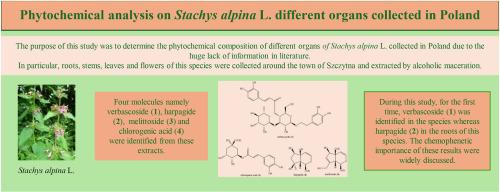Phytochemical analysis on Stachys alpina L. different organs collected in Poland
IF 2
4区 生物学
Q4 BIOCHEMISTRY & MOLECULAR BIOLOGY
引用次数: 0
Abstract
The purpose of this study was to determine the phytochemical composition of different organs of Stachys alpina L. collected in Poland, in light of the significant lack of data available in the literature. In particular, roots, stems, leaves and flowers of this species were collected around the town of Szczytna and extracted by alcoholic maceration. Four molecules–namely verbascoside (1), harpagide (2), melittoside (3) and chlorogenic acid (4)–were identified from these extracts by comparing their spectroscopic data with those reported in the literature. Some of these were found in common but none of them was reported in all the studied organs. In addition, during this study, for the first time, verbascoside (1) was identified in the species whereas harpagide (2) in the roots of this species. The chemophenetic significance of these findings is discussed in detail.

波兰产白菖蒲不同器官的植物化学分析
鉴于文献资料的缺乏,本研究的目的是确定在波兰收集的Stachys alpina L.不同器官的植物化学成分。特别是在Szczytna镇附近收集了该物种的根、茎、叶和花,并用酒精浸渍法提取。通过与文献报道的光谱数据进行比较,从这些提取物中鉴定出四种分子,即毛蕊花苷(1)、哈弗苷(2)、麦蕊花苷(3)和绿原酸(4)。其中一些是共同发现的,但没有一个在所有被研究的器官中被报道。此外,在本研究中,首次在该物种中鉴定出毛蕊花苷(1),而在该物种的根中鉴定出哈巴苷(2)。详细讨论了这些发现的化学化学意义。
本文章由计算机程序翻译,如有差异,请以英文原文为准。
求助全文
约1分钟内获得全文
求助全文
来源期刊

Biochemical Systematics and Ecology
生物-进化生物学
CiteScore
3.00
自引率
12.50%
发文量
147
审稿时长
43 days
期刊介绍:
Biochemical Systematics and Ecology is devoted to the publication of original papers and reviews, both submitted and invited, in two subject areas: I) the application of biochemistry to problems relating to systematic biology of organisms (biochemical systematics); II) the role of biochemistry in interactions between organisms or between an organism and its environment (biochemical ecology).
In the Biochemical Systematics subject area, comparative studies of the distribution of (secondary) metabolites within a wider taxon (e.g. genus or family) are welcome. Comparative studies, encompassing multiple accessions of each of the taxa within their distribution are particularly encouraged. Welcome are also studies combining classical chemosystematic studies (such as comparative HPLC-MS or GC-MS investigations) with (macro-) molecular phylogenetic studies. Studies that involve the comparative use of compounds to help differentiate among species such as adulterants or substitutes that illustrate the applied use of chemosystematics are welcome. In contrast, studies solely employing macromolecular phylogenetic techniques (gene sequences, RAPD studies etc.) will be considered out of scope. Discouraged are manuscripts that report known or new compounds from a single source taxon without addressing a systematic hypothesis. Also considered out of scope are studies using outdated and hard to reproduce macromolecular techniques such as RAPDs in combination with standard chemosystematic techniques such as GC-FID and GC-MS.
 求助内容:
求助内容: 应助结果提醒方式:
应助结果提醒方式:


